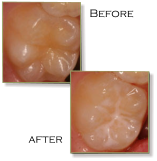Sealants are thin layers of resin that are bonded into the pits, fissures, and grooves of permanent molars to prevent decay on these surfaces.
The majority of decay on back teeth starts in the grooves and pits of chewing surfaces, especially during the first few years after their eruption. Sealing these surfaces just after eruption (usually around six years old) with composite resins prevents this kind of decay. Sealants are generally not done on primary (baby) teeth.
Sealants are one of the most effective methods of preventing decay on the surfaces where they are placed. Although there is still a possibility that decay may develop on surfaces in between teeth, sealants placed on teeth at greatest risk significantly reduce the overall chance of having cavities and are strongly advised.


